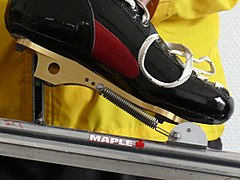Folding ice skate
The folding ice skate is a modification of the traditional ice skate , which was specially designed for speed skating , in which the blade is no longer rigidly attached to the shoe, but is mounted on a folding joint.
Background, story
The technique of speed skating is based on alternating gliding on one skate, while the other skate is used to push off. In the final phase of the push-off process with the leg extended, the runner leaves the ice as the angle increases. Pushing off in this phase is no longer possible or would have a braking effect, as the end of the runner would then cut massively into the ice .
Nevertheless, the idea arose to extend the last phase of the push off by making structural changes to the ice skate. Karl Hannes from Würzburg submitted the first patent application for a foldable skate blade to the Imperial Patent Office in 1896. Despite the granted patent, the idea could not prevail and was forgotten again. The first attempts with movable runners for competitive sports were made in the 1970s in sports research in the GDR . For various reasons (internal discussions, questionable conformity with the rules, possibly also a lack of funds) these attempts were soon stopped.
In the Netherlands , where speed skating is a popular sport, the idea was taken up again in the 1990s and promoted to readiness for use by Erik van Kordelaar and Dick de Bles . In the developed principle, the runner connected to the running shoe is pivoted at the front and can fold down with the rear end. A spring pulls the runner back when the runner finally lifts the foot. As a result, the runner stays longer on the ice along its entire length and thus extends the push-off phase while the runner is already lifting the heel. Especially on the longer routes, this leads to significant time improvements compared to conventional ice skating. The positive effect of the folding runners is particularly evident when cornering.
First use took place at the junior championships 1992/93 in South Holland. In 1996 the Dutch women's team used the folding ice skate for the first time in international competitions, Marianne Timmer won the 1998 Winter Olympics in Nagano .
The mastery of the folding technique is demanding in the jump-like running steps at the beginning of the running route. On the sprint courses, in which this critical initial phase is a major part, there were initially difficulties with the folding technique. In the meantime, the times on the first hundred meters have also become shorter than when using the old skate models with firmly locked runners. The folding ice skate therefore also prevailed in sprint competitions and is now used by almost all athletes in top-class speed skating.
technology
The narrow speed skating runners are embedded in a mostly tubular metal construction, the torpedo. While the chassis of classic speed skating shoes consists of only two support elements between the shoe sole and torpedo, an additional longitudinal rail is screwed under the shoe sole for folding ice skates. This is necessary to ensure the torsional rigidity of the system. In the front area of the rail there is a roller or slide bearing to which the torpedo is attached. Under the heel there is a second receptacle for the torpedo to provide additional lateral guidance when folded and to absorb the strong forces at the beginning of the push-off process. Both wedge-shaped and conical mountings are used here. In the unloaded state , the runner is pulled to the shoe via one or more springs . Tension springs are usually used for this, but torsion springs are also used. Typically, the force of the spring can be adjusted via different articulation points. Alternatively, springs of different spring stiffness can be used. The additional rail under the shoe, the storage and the spring mechanism make folding ice skates heavier than classic speed skating skates.
photos
Web links
Individual evidence
- ↑ Karl-Heinz Bergmann: Karl Hannes from Würzburg already registered a patent for the folding ice skate in 1894: The future is already a hundred years old. In: Berliner Zeitung. Retrieved February 15, 2018 .
- ↑ R. Daugs, St. Panzer, A. Ehrig, A. Toews, K. Fieguth: conversion, retraining and restructuring of highly trained athletic movements. In: BISp-Jahrbuch 2000. Federal Institute for Sport Science, accessed on February 15, 2018 .




